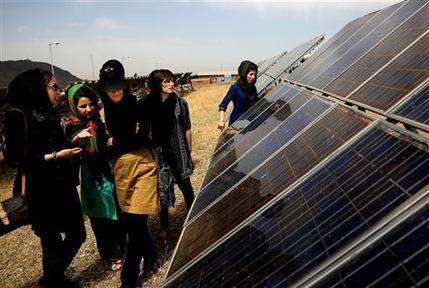[caption id="attachment_104226" align="alignright" width="194"] In this June, 22, 2014 photo, Iranian students tour the Taleghan Renewable Energy Site in Taleghan,160 kilometers (99 miles) northwest of capital Tehran, Iran. Solar has been a hot topic of discussion in Iran, which this year fielded a team of university students to compete in a U.S. solar car contest in July. Saman Mirhadi, a senior government official, said the government installed solar panels at some 1,000 locations across Iran, including the rooftops of mosques, schools and government buildings. (AP Photo/Ebrahim Noroozi)[/caption]
In this June, 22, 2014 photo, Iranian students tour the Taleghan Renewable Energy Site in Taleghan,160 kilometers (99 miles) northwest of capital Tehran, Iran. Solar has been a hot topic of discussion in Iran, which this year fielded a team of university students to compete in a U.S. solar car contest in July. Saman Mirhadi, a senior government official, said the government installed solar panels at some 1,000 locations across Iran, including the rooftops of mosques, schools and government buildings. (AP Photo/Ebrahim Noroozi)[/caption]
SICHANLOO, Iran (AP) -- In this village nestled in the arid hills of rural Iran, government-subsidized solar panels on the rooftops of homes provide both needed electricity and a shining symbol of efforts by the Islamic Republic to wean itself off fossil fuels and nuclear power.
President Hassan Rouhani's government has quintupled its spending on solar power projects in the last year, taking advantage of Iran's 300-odd days of sunshine a year that make its vast sun-kissed lands one of the best spots on earth to host solar panels. While being good for the environment, the panels also offer rural Iran steady power amid uncertainty over the country's contested nuclear program as it negotiates with world powers.
And as the Islamic Republic cuts back on subsidies that once made gasoline cheaper than bottled mineral water, a push toward self-sustaining solar power could help the government save money and bolster its sanctions-battered economy.
"A big change is in the making in Iran," said Saman Mirhadi, a senior government official in charge of solar projects.
Iran, home to some 77 million people, is a fossil-fuel powerhouse, even in the crude-oil rich Middle East. It is home to both the world's fourth-largest proven oil reserves and massive natural gas reserves.
However, sanctions have cut into the country's refining and production capabilities. Iran's economy also has faltered, while the country's push for nuclear energy has come under scrutiny over Western fears the Islamic Republic could use its program to build atomic bombs. Iran has said its program is for peaceful purposes.
Rouhani's administration, however, sees a bright future in solar, spending $60 million this year on solar projects compared to just $12 million last year. It especially wants to target rural communities largely cut off from government services across the country. In Sichanloo, a hamlet 200 kilometers (125 miles) northwest of the capital Tehran, the seven families who live here once relied on gasoline-fueled generators for electricity.
Now, more than two dozen solar panels shine from nearby rooftops. With the flip of a switch, electricity stored in truck-sized batteries from the solar panels lights up the home of Habibollah Kakavand, the father of one of the village's families.
"In the past, we used gasoline-fueled power generators to meet our electricity needs in the absence of a grid network. It needed fuel plus maintenance, which was costly. It also had a lot of noise and caused pollution," he said. "But the government has supplied free solar energy. It doesn't need fuel and has made life comfortable for us."
Kakavand's wife Mehri nodded in agreement as she swept the Persian carpets in the house using a vacuum cleaner powered by the solar panels.
Solar has been a hot topic of discussion in Iran, which this year fielded a team of university students to compete in a U.S. solar car contest in July. Mirhadi said the government installed solar panels at some 1,000 locations across Iran, including the rooftops of mosques, schools and government buildings.
Jafar Mohammadnejad, a senior Energy Ministry official, said recently passed laws and incentives encourage domestic and foreign investment in renewable energy projects in Iran. It remains unclear what percentage renewable energy accounts for in Iran's energy portfolio, though he said officials hope to produce 5,000 megawatts from renewable resources within two years. Fees on electricity bills pay for the expansion.
"Iran is rich in oil, gas and other fossil energy resources. Yet it has opted to turn to renewable energy. This shows Iran's new strategic energy direction," Mohammadnejad said.
Although fossil fuel is still supplied to Iranians at subsidized prices, a raise in prices earlier this year - plus a consistent drop in the price of foreign-manufactured solar panels - is making solar power more affordable. Yet challenges remain, officials acknowledge.
"More difficult than installing solar panels," is changing the habits of people "who have got accustomed to cheap non-solar energy," said Yusof Armoodli, head of Iran's renewable energy department.
By The Associated Press
The Iran Project is not responsible for the content of quoted articles.

 QR code
QR code